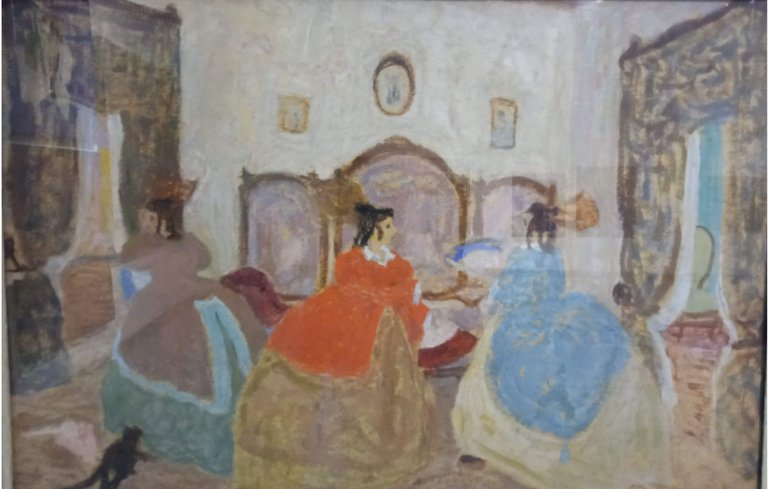
Autor: PEDRO FIGARI - (URUGUAYO)
(Montevideo, Uruguay, 1861 – 1938)
Título: Las vecinas
Fecha: 1927-1932
Técnica: Óleo sobre cartón
Dimensiones: 50 x 70 cm
Colección: FMN - Museo de Bellas Artes de Caracas
Foto digital: Gladys Yunes Yunes
Author: PEDRO FIGARI - (URUGUAYO)
(Montevideo, Uruguay, 1861 – 1938)
Title: The neighbors
Date: 1927-1932
Technique: Oil on cardboard
Dimensions: 50 x 70cm
Collection: FMN - Museum of Fine Arts of Caracas
Digital photo: Gladys Yunes Yunes
……………………………………………………………….
A continuación les presento un texto analítico de la obra del artista uruguayo Pedro Figari que actualmente se exhibe en la sala 6 del Museo de Bellas Artes de Caracas. Las vecinas, 1927-1932, es el título de esta pieza que representa la plástica de principios del siglo XX en América Latina.
La obra de Pedro Figari se acerca al género costumbrista, mediante el cual el artista busca mostrar el ambiente cultural y natural de la región latinoamericana. De ahí que sus composiciones se enfoquen hacia los paisajes de cielo abierto que describen las pampas con sus imponentes árboles de ombúes, así como los ambientes domésticos de los pueblos sureños en los que describe la población criolla en su diaria cotidianidad. A este segundo tema pertenece la obra Las vecinas, 1927-1932, en la que el autor representa un grupo de mujeres que se dedican al chismorreo y a espiar lo que sucede en las afueras de su residencia. Figari construye la escena mediante una pincelada amplia y generosa que retrata los personajes en el interior de una casa, decorada según la usanza de la época con grandes ventanales. Tanto la selección del tema como la técnica empleada, conformada por manchas de color y trazos imprecisos, le confieren a este lienzo un rasgo de modernidad que es característico de la pintura producida en América Latina, a comienzos del siglo XX, orientada primordialmente al reconocimiento del entorno, así como a la presencia de sus habitantes.
The following is an analytical text on the work of Uruguayan artist Pedro Figari, currently on display in Room 6 of the Museo de Bellas Artes in Caracas. Las vecinas, 1927-1932, is the title of this piece that represents the plastic art of the early twentieth century in Latin America.
Pedro Figari's work is close to the costumbrista genre, through which the artist seeks to show the cultural and natural environment of the Latin American region. Hence, his compositions focus on the open-sky landscapes that describe the pampas with their imposing ombú trees, as well as the domestic environments of the southern towns in which he describes the Creole population in their daily lives. The work The Neighbors, 1927-1932 belongs to this second theme, in which the author represents a group of women who dedicate themselves to gossiping and spying on what is happening outside their residence. Figari builds the scene with a broad and generous brushstroke that portrays the characters inside a house, decorated according to the style of the time with large windows. Both the selection of the subject and the technique used, made up of spots of color and imprecise strokes, give this canvas a trait of modernity that is characteristic of the painting produced in Latin America, at the beginning of the 20th century, primarily oriented to the recognition of the environment, as well as the presence of its inhabitants.
A lo largo de su fructífera trayectoria, Pedro Figari se desempeñó como artista, abogado, político, escritor y periodista. En 1918 abandonó todas sus actividades para dedicarse a la pintura, pues hasta entonces había sido un "pintor de fin de semana" y contaba con una obra apenas conocida fuera del ámbito familiar. En 1921 se traslada a Buenos Aires, capital en la que permanece cuatro años y donde obtiene reconocimiento por su trabajo pictórico; desde allí viaja a París, ciudad en la que vive nueve años, convirtiéndose en un testigo y observador de las vanguardias artísticas que se desarrollaban en aquel momento en la urbe francesa. En 1934 regresa a Uruguay, su tierra natal donde fallece cuatro años más tarde a la edad de setenta y siete años. La obra Las vecinas, 1927-1932, ingresó a la Colección de Arte Latinoamericano del Museo de Bellas Artes de Caracas en 1959.
Throughout his fruitful career, Pedro Figari worked as an artist, lawyer, politician, writer and journalist. In 1918 he abandoned all his activities to dedicate himself to painting, since until then he had been a "weekend painter" and his work was barely known outside the family sphere. In 1921 he moved to Buenos Aires, the capital where he remained for four years and where he obtained recognition for his pictorial work; From there he traveled to Paris, a city where he lived for nine years, becoming a witness and observer of the artistic avant-garde that was developing at that time in the French city. In 1934 he returned to Uruguay, his homeland, where he died four years later at the age of seventy-seven. The work The Neighbors, 1927-1932, entered the Latin American Art Collection of the Museum of Fine Arts of Caracas in 1959.
Gladys Yunes Yunes, Noviembre 2024
Gladys Yunes Yunes, November 2024
¿ᴺᵉᶜᵉˢᶦᵗᵃˢ ᴴᴮᴰ? ᵀᵉ ˡᵒ ᵖʳᵉˢᵗᵃᵐᵒˢ ᶜᵒⁿ @ruta.loans
Congratulations @yunesyunesarte! You have completed the following achievement on the Hive blockchain And have been rewarded with New badge(s)
Your next target is to reach 700 upvotes.
You can view your badges on your board and compare yourself to others in the Ranking
If you no longer want to receive notifications, reply to this comment with the word
STOPSaludos maestra, espero que este bien, me alegra que aporte dentro de la comunidad información sobre este interesante pintor, quien nos aporta las costumbres del uruguay de la época, espero indagar un poco mas sobre este interesante pintor.